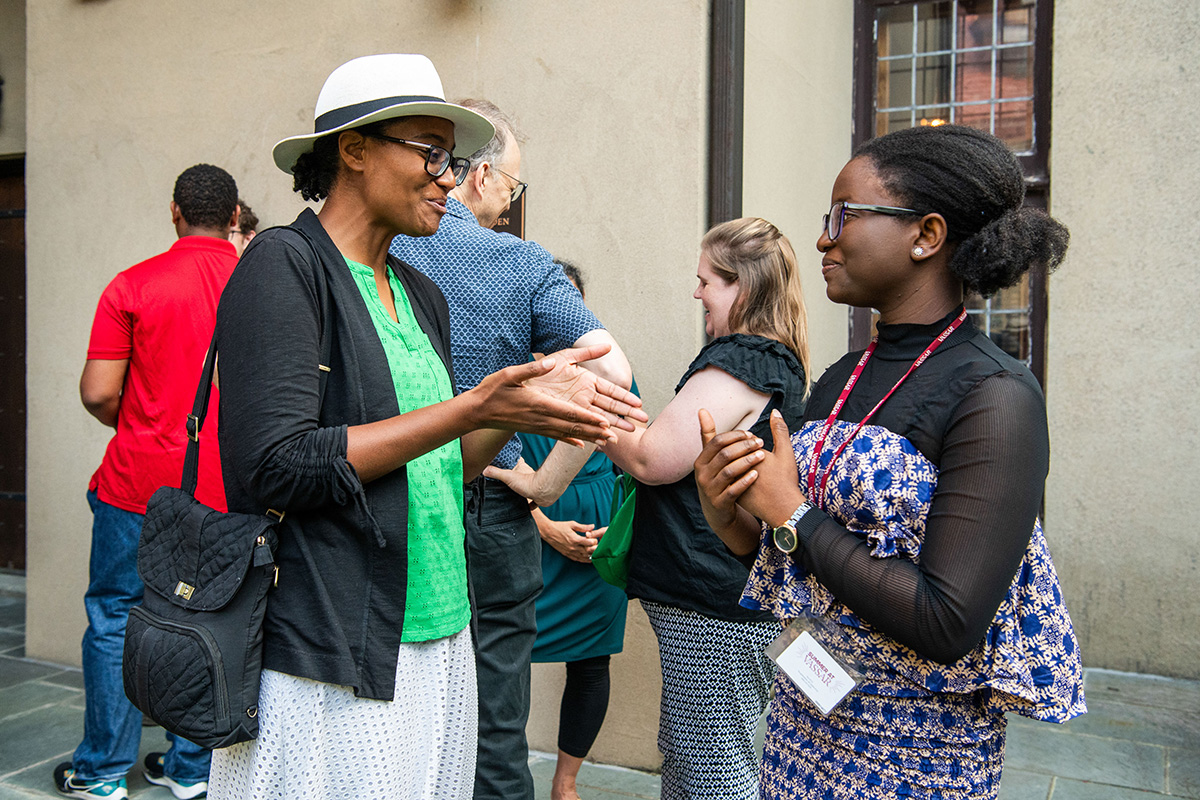Three-Year Study on Improving Graduation Rates to Culminate with Education Summit on April 29
Why do some colleges and universities—even those with limited resources—achieve high graduation rates while others do not? Over the past three years, several Vassar administrators, a faculty member, and a student have been engaged in research designed to help answer this question. They will present their findings and continue this discussion at a symposium on April 29 at The Vassar Institute for the Liberal Arts. About 65 representatives from more than a dozen colleges, universities, and foundations are expected to attend.

Photo by Lucas Pollet
Wendy Maragh Taylor, Associate Dean of the College for Student Growth and Engagement and a key architect of the studies, said the goal of the research was to explore best practices with higher education institutions who have higher than expected graduation rates. This is fueled by an interest in improving what she called “disappointing” persistence and retention to completion rates, and highlighting those who are doing it well. “Many schools have achieved success in enrolling a more diverse student body, but graduation rates have not shifted,” Maragh Taylor said. “Only about 51 percent of those who enroll in colleges and universities graduate in six years.”
The studies, funded by the Lumina Foundation and ECMC Foundation, revealed that colleges with robust mental health support systems often exceed this number. “Many colleges with large endowments and high faculty resources do better,” she said (at Vassar, graduation rates typically exceed 90 percent). “But we found several factors that contribute to higher graduation rates, regardless of the institution’s endowment.”

Photo by Kelly Marsh
Colleges that are committed to providing mental health services and have a culture of supporting such students often succeed where other colleges fail. “Those that have a unique and compelling history of focusing on the needs of their students often do better,” Maragh Taylor said.
Other institutions in the study with successful outcomes included those that have comprehensive plans in place for helping students manage setbacks, and those that enable everyone on campus—administrators, faculty and students—to have a voice in decision making.
Maragh Taylor noted that most of these factors do not depend on the size of the institution’s endowment. “In most cases, it didn’t take a lot of money for these colleges to accomplish these things,” she said. “It was just a matter of having the proper priorities and strategies in place.”
President Elizabeth Bradley, who spearheaded the research team, said the data gathered indicated that the most successful institutions took a holistic approach to supporting their students. “One of the main takeaways of our study was that these schools integrate attention to mental health issues in everything they do,” Bradley said. “They have early warning signs in place that prevent the need for expensive care. It’s deeply embedded in the culture of the institution; it’s everybody’s job.”

Photo by Ben Richardson '25
Others who took part in the research, in addition to Maragh Taylor and Bradley, were Mariam Eshetu ’24, who took part in the study when she was a student; Christopher Bjork, Professor of Education; Bini Tesfamariam, Director of Institutional Research and Decision Support; Michelle Quock, Director of Vassar’s First-Generation, Low Income (FLI) Program; Charlotte Gullick, Interim Director of Vassar’s Exploring Transfer Program and ETT Program Manager; Marianne Begemann, Dean of Strategic Planning and Academic Resources; Carlos Alamo, Dean of the College; Nicole Beveridge, Director of the Jeh Vincent Johnson Cultural Center; Angeli Pinol, Data and Reporting Analyst for Institutional Research, and Kathleen Vu, Program Manager for the Lumina Research Team.
Vu, who was one of several researchers to visit other colleges, said she was “inspired” by the experience. “What really struck me was the culture of care at each campus,” she said. “It was clear that student retention was everyone's responsibility, from student-facing staff, faculty, administrators, and university leadership. It wasn't just the responsibility of one department or resource center. Each institution had a unique history of how they formed, and it seems like that history and campus mission attracted like-minded faculty and staff. For instance, one public research university we visited formed to serve first-generation and low-income students in the agricultural city they were based in. This college is relatively young and with it being new, there’s an entrepreneurial spirit to it. The professors who worked at that college were really passionate about working with first-generation college students and they were open to trying new strategies to improve their teaching, such as implementing flipped classrooms in science classes that they noticed students tended to struggle in.”
Eshetu ’24, who took part in the study starting when she was a student, said she found the work challenging but rewarding. “We found that mental health plays a big role in enabling students to stay in college,” she said. “It’s good to know that our findings can help students across the country as we spread the word about our study. And it’s significant that many of these colleges had below-average resources but had proactive programs in place that were effective in achieving higher graduation rates.”
One of the studies conducted by some of the Vassar researchers focused specifically on ways to improve graduation rates among community college students who enrolled with an intention of graduating from a four-year college. According to surveys conducted by the Vassar researchers, about 80 percent of those who enroll in community college said this was their goal, but fewer than 20 percent actually achieved it. However, of those who enrolled in Vassar’s Exploring Transfer program—a six-week session that brings these students to Vassar to take sample courses they will encounter at four-year colleges and introduces them to ways of coping with life on a college campus—more than 80 percent achieved this goal.
Gullick was a co-author of four papers on the topic that have been published in higher education journals. She said the Education Summit would “highlight the work all of us have done on the challenges involved in improving college completion rates. Many higher education changemakers will be attending, as well as some of our Exploring Transfer (ET) graduates to address this topic.”
“Our ET program is unique in that it gives community college students residential living and learning experience on a college campus,” Gullick said. Recently, two other liberal arts colleges, Bryn Mawr and Haverford, announced they will jointly host a program based on Vassar’s model this summer.
Maragh Taylor said that she often receives heartwarming notes from Exploring Transfer graduates. Recently, one former participant, Maria Thornton, wrote to her, saying she had received her bachelor’s degree from Hunter College and a master’s in public administration from Columbia University School of International and Public Affairs. “ET changed my life,” Thornton said in her note.
Maragh Taylor said she was convinced that the work the Vassar researchers had done could ultimately lead to better outcomes for colleges and universities and the students who are enrolled there. “It’s been an eye-opening experience, and exciting to see the interest and passion so many in higher education have about these issues,” she said. “The more students who graduate, the more educated the citizenry becomes and the better the decisions they make. This work is important, as a college degree still affords individuals the opportunity for better life outcomes. The research is clear about that. Our team is glad to contribute to the conversation.”
Gullick called the Education Summit “the culmination of a lot of work by a lot of people, and I appreciate the fact that Vassar is committed to being a visionary for the success of all students, not just those at Vassar.”